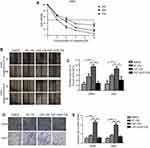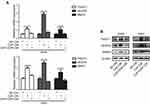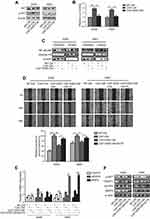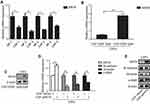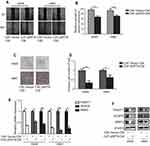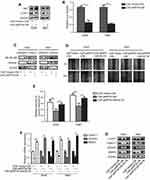Back to Journals » OncoTargets and Therapy » Volume 13
The Metastasis Potential Promoting Capacity of Cancer-Associated Fibroblasts Was Attenuated by Cisplatin via Modulating KRT8
Authors Li X, Song Q, Guo X, Wang L, Zhang Q, Cao L, Ren Y, Wu X, Meng Z, Xu K
Received 16 January 2020
Accepted for publication 19 March 2020
Published 1 April 2020 Volume 2020:13 Pages 2711—2723
DOI https://doi.org/10.2147/OTT.S246235
Checked for plagiarism Yes
Review by Single anonymous peer review
Peer reviewer comments 3
Editor who approved publication: Prof. Dr. Takuya Aoki
Xueqin Li,1,* Qianqian Song,1,* Xueru Guo,1,* Limin Wang,1 Qicheng Zhang,1 Limin Cao,1 Yinghui Ren,1 Xiang Wu,2 Zhaowei Meng,3 Ke Xu1
1Tianjin Key Laboratory of Lung Cancer Metastasis and Tumor Microenvironment, Tianjin Lung Cancer Institute, Tianjin Medical University General Hospital, Tianjin 300052, People’s Republic of China; 2Core Facility Center, Tianjin Medical University General Hospital, Tianjin 300052, People’s Republic of China; 3Department of Nuclear Medicine, Tianjin Medical University General Hospital, Tianjin 300052, People’s Republic of China
*These authors contributed equally to this work
Correspondence: Ke Xu
Tianjin Key Laboratory of Lung Cancer Metastasis and Tumor Microenviroment, Tianjin Lung Cancer Institute, Tianjin Medical University General Hospital, Tianjin 300052, People’s Republic of China
Email [email protected]
Zhaowei Meng
Department of Nuclear Medicine, Tianjin Medical University General Hospital, Tianjin 300052, People’s Republic of China
Email [email protected]
Background: Cancer-associated fibroblasts (CAFs) are an essential component of tumor microenvironment. They are attracting increasing attentions due to their crucial role in tumor growth, drug-resistance and metastasis. Cisplatin is a first-line chemotherapy drug applying in various types of cancer. There are intensive studies on cisplatin’s effect on tumor cells, however, its effect on CAFs remains poorly understood. In the present study, we investigated the effect of cisplatin on CAFs.
Methods: Cell migration was detected by wound healing assay. Cell invasion was performed by the transwell assay. mRNA expression was detected by quantitative PCR, and protein expression was detected by Western blotting. Tumor growth was measured using BALB/c nude mice tumor models.
Results: Cisplatin attenuated the promoting capacity of CAFs on lung cancer cell migration and invasion, via suppressing CAFs’ effect on metastasis-related genes including Twist1, vascular endothelial growth factor receptor (VEGFR), MMP2, and AKT signaling pathway. Keratin 8 (KRT8) was identified as a target of cisplatin. KRT8 upregulation in CAFs is responsible for the inhibitory effect of cisplatin on lung cancer cells metastasis potential through AKT pathway suppression. The stimulation of AKT by AKT activator SC79 reversed KRT8’s effect on cell migration. Importantly, in vivo study also showed that CAFs enhanced tumor growth significantly, and cisplatin effectively abrogated the promoting effect of CAFs on tumor growth.
Conclusion: Our results revealed a novel mechanism that cisplatin attenuated the metastasis promoting effect of CAFs via KRT8/AKT signaling pathway. This finding highlights KRT8 in CAFs as a potential therapeutic candidate for metastasis treatment.
Keywords: cancer-associated fibroblasts, KRT8, lung cancer, metastasis, cisplatin, AKT
Introduction
Lung cancer is the most common type of cancer, and is the leading cause of cancer-related mortality worldwide. According to the latest report from GLOBOCAN 2018, there are approximately 2.1 million new cases (11.6% of all sites) and 1.7 million death (18.4% of all sites) for lung cancer in 2018.1 Pathologically the majority subtype of lung cancer is non-small cell lung cancer (NSCLC), that accounts for 80% of total lung cancer. Because most lung cancer patients were at advanced stage when were diagnosed, in particular, many of them present metastasis at remote location, chemotherapy is the major treatment option. The platinum-based chemotherapy is currently the standard first-line cytotoxic treatment, however, the clinical efficacy of chemotherapy is poor, leaving the 5-year survival rate only 15%.2
Most studies on chemotherapy are concentrated on characteristics of tumor cells, not until recently, tumor microenvironment (TME) attracts more attentions. The communications between cells and the microenvironment are crucial for both normal and tumor tissue. In particular, the interactions between tumor cells and TME result a powerful relationship that facility tumor progression. Accumulating evidences have suggested that TME play a vital role in three stages of tumorigenesis: initiation, progression and metastasis.3,4
TME consists of many components, such as stromal cells, extracellular matrix (ECM), blood and lymphatic vascular networks.4 CAFs are essential components of TME. They play pivotal roles in tumor progression in various types of tumor, such as lung cancer,5 breast cancer,6 pancreatic cancer.7 CAFs are involved in many physiological processes such as epithelial–mesenchymal transition (EMT), chemoresistance, matrix remodeling, metastasis and immunosuppression by secreting cytokines and growth factors and creating an optimal microenvironment for tumor cells.8,9
Although people have made great achievement on understanding the mechanisms of chemotherapy on tumor cells, the mechanisms underlying the effect of chemotherapy on TME remains unelucidated. Our previous RNA sequencing study showed that CAFs express lower level of KRT8 compared to normal fibroblasts (NFs),10 suggesting that KRT8 may play a role in cisplatin effect. In the present study, we have explored the effect of cisplatin on the promoting effect of CAFs on lung cancer metastasis, and we found that cisplatin attenuated the metastasis enhancing effect of CAFs via KRT8/AKT signaling pathway. In order to investigate this effect in vivo, we also use a BALB/c nude mice tumor models to measure the effect of cisplatin on tumor growth.
Materials and Methods
Reagents
Cisplatin (DDP) (Cat. No. P4394) was purchased from Sigma-Aldrich Inc. (St Louis, MO). Akt phosphorylation activator SC79 (Cat. No. S7863) was purchased from Selleck (Houston, TX). pNFκB–Luc plasmid (Cat. No. D2206) and Nuclear extraction kit (Cat. No. P0027) was purchased from Beyotime Biotechnology (Jiangsu, China).
Antibodies used for Western blottings: KRT8 (Cat. No. ab53280), SMA (Cat. No. ab124964) were purchased from Abcam (Cambridge). Vimentin (Cat. No. 550513) was from BD Bioscience (San Jose). N-cadherin (Cat. No. 14215S), Twist1 (Cat. No. 46702S), MMP2 (Cat. No. 4022S), VEGFR (Cat. No. 9898S), AKT (Cat. No. 9272S), p-AKT (Cat. No. 4060S), p65 (Cat. No. 4764S), Histone H3 (Cat. No. 4499S) were from Cell Signaling Technology (Beverly, MA). β-actin (Cat. No. A1978) was from Sigma-Aldrich.
Cell Culture and Clinical Specimens
Human lung cancer cell lines H661 and A549 were purchased from the American Type Culture Collection (Manassas, VA). H661 and A549 cells were grown in DMEM medium at 37°C, 5% CO2. Medium contains 10% fetal bovine serum, 1% glutamine, 1% sodium pyruvate (Invitrogen).
All clinical specimens in this study were obtained at the Tianjin Medical University General Hospital. Patients were clinically and pathologically diagnosed as NSCLC. Written informed consent was obtained from patients. This study has been approved by the Ethical Review Committee of the hospital (TMUaMEC 2014007), and was conducted in accordance with the Declaration of Helsinki.
Stromal Fibroblasts Isolation
CAFs and NFs were obtained from surgical tumor tissues and adjacent non-tumor tissues, respectively. CAFs and NFs were isolated and characterized as previously described.11
For the preparation of the conditioned medium (CM), NFs and CAFs isolated from three tissue specimens were mixed, treated with 2 µM cisplatin for 24 hrs, then the cisplatin-containing medium was replaced with fresh medium and cultured for 48 hrs and collected.
Cell Viability Assay
CAFs were placed in a 96-well plate at a density of 4 x 103 cells/well, then treated with 0–10 µM of cisplatin for 48 hrs. The cell viability was measured using a Cell Counting Kit (CCK-8, Dojindo, Kumamoto, Japan) following the manufacture’s instruction. The median inhibitory concentration IC50 was calculated using GraphPad Prism 5.
Wound Healing Assay
Cell migration was detected by wound healing assay as previously described.12 Briefly, cells were seeded in six-well plates. Pipette tips were used to create a clean cross-would in the well, and the cell debris was removed by PBS. Then CM was added and cells were cultured for 48 hrs. The scratch images were observed by a microscope (Nikon, Tokyo, Japan) at ×40 magnification. The healing area was calculated by Image J Analysis software (National Institutes of Health, MD)
Cell Invasion Assay
Cell invasion was performed by the trans-well assay (Costar, New York, NY) as previously described.13 Lung cancer cells were pretreated with various CM for 48 hrs, then were added to the insert. Related medium was added to the lower compartment of the chamber. After 48 hrs of incubation, the invaded cells on the lower surface of the insert were fixed with 75% ethanol, and stained with 1% crystal violet (Beyotime, Jiangsu, China). Four randomly selected fields were counted by a microscope.
Western Blot Analysis
Western blottings were carried out as previously described.14 Briefly, after washed with PBS, cells were lysed with RIPA buffer which contains protease inhibitor (Sigma). Then samples were electrophoresis on SDS-PAGE and transferred to nitrocellulose membranes. After blocked with 0.1% Tween 20 in PBS containing 5% non-fat milk for 1 hr, the membrane was probed with primary antibody overnight, and HRP-conjugated secondary antibody for another hour. The blots were developed with Chemiluminescent HRP Substrate (Millipore, Bedford, MA, USA).
Quantitative PCR
The RNA was extracted with Trizol reagent (Invitrogen). The reverse transcription was carried out using the Takara kit (Otsu, Japan). The gene expression was detected by qPCR by Power SYBR Green Master Mix (ABI, Foster City, CA), on an 7500 ABI Prism Sequence Detector. GAPDH was used as a house keeping gene. The relative expression level of genes was analyzed by using 2−ΔΔCt method. All primers were designed by Primer 5.0 (Table 1).
 |
Table 1 PCR Primer Sequences |
Transfection and Luciferase Reporter Assay
The full-length cDNA of human KRT8 was amplified (forward primer 5ʹ-CGCGGATCCATGAATGGGGTGAGCTGGAGCCAG-3ʹ, reverse primer 5ʹ-GGAATTCTCACTTGGGCAGGACGTCA-3ʹ) and cloned into pcDNA3.1+ vector. Cell transfection was performed with lipofectamine 2000 from Invitrogen, following Invitrogen’s instruction. Briefly, cells were transfected with 100 ng of p-NFκB-luc plasmid. The luciferase assay was performed using the Dual-luciferase Reporter Assay System (Promega, Madison, WI) using a LB 941 BERTHOLD TriStar (Bad Wildbad, Germany).
Mouse Tumor Models
Female BALB/c nude mice (4-weeks old, 16–20 g) were obtained from the Chinese Academy of Medical Science (Beijing, China). Xenograft experiments were approved and conducted under the guidelines of the Tianjin Medical University Institutional Animal Care and Use Committee. Mice were maintained under specific pathogen-free conditions, and in a climate control environment. Mice were divided randomly into two research groups, each group consists of five mice. 3×106 of A549 cells alone or mixed with 9×106 of CAFs treated with 2 μM cisplatin (ratio 1:3) was injected subcutaneously into the left or right flank of the mice. Tumors were measured every 7 days, and the volume was calculated as: volume =d2 × D/2, where D was the longest diameter, and d was the shortest diameter. The experiment had been executed for 6 weeks. At the end of the study, mice were euthanized by intraperitoneal injection of pentobarbital (100 mg/kg). Mice tumor tissues were dissected for future Western blottings analysis.
Statistical Analysis
All data were presented as mean ± SD from at least three independent experiments. One-way ANOVA was used to analyze the differences between groups. P values were calculated, and P < 0.05 was considered as statistically significance.
Results
Cisplatin Suppressed the Promoting Effect of CAFs on Metastasis Potential of Lung Cancer Cells
We first investigated the cytotoxic effect of cisplatin on CAFs. CAFs isolated from lung cancer specimen were treated with 0–10 µM of cisplatin (DDP) for 24 to 72 hrs, cell viability was detected by CCK-8 assay. Figure 1A showed that cisplatin effectively inhibited the proliferation of CAFs. For 48 hrs treatment, the IC50 of cisplatin on CAFs was 3.82 ± 0.48 µM. We selected 2 µM cisplatin which is not very toxic to CAFs for further study.
In order to define the effect of cisplatin on CAFs’ function, CAFs were treated with 2 µM cisplatin for 24 hrs, then the cisplatin containing medium was replaced with fresh medium and cultured for further 48 hrs. The conditioned medium CAF+DDP-CM were collected and used to culture lung cancer cells for 48 hrs. Because there were approximately 65% viable cells remained after DDP-treatment, in order to collect the conditioned medium from same amount of viable CAFs at the end of the treatment between DDP-treated and untreated samples, we added 53.8% more CAFs in treatment samples at the start of the treatment.
Wound healing assay was performed to examine cell migration ability. As shown in Figure 1B and C, the adhesive rate of A549 and H661 cells cultured in DMEM medium were 27.0% and 45.2%, respectively. CAF-CM increased the adhesive rate to nearly 100%; interestingly, CAF+DDP-CM dramatically reduced the adhesive rates to 62.3% in A549 cells and 71.2% in H661 cells, respectively. Next, we studied the CAF+DDP-CM’s effect on cell invasion by trans-well assay. CAF-CM increased cell invasion by 4.1-fold in A549 cells and 2.9-fold in H661 cells compared to DMEM medium, however, CAF+DDP-CM increased cell invasion by merely 1.3-fold in A549 cells and 1.4-fold in H661 cells (Figure 1D and E). These data indicated that cisplatin suppressed the promoting effect of CAFs on metastasis potential of lung cancer cells.
Cisplatin Abrogated CAFs’ Effect on Metastasis-Related Genes in Lung Cancer Cells
Since our results demonstrated that cisplatin affected the effect of CAFs on lung cancer cell metastasis, we further investigated their effect on metastasis-related genes.
Numerous studies showed that Twist, VEGFR and MMP2 play important roles in metastasis, we therefore focused on these genes.15–17 Lung cancer cells were cultured in CAF-CM or CAF+DDP-CM. The mRNA expression was detected by qPCR. CAFs increased the mRNA level of these genes in lung cancer cells. In A549 cells, VEGFR was regulated most significantly among these genes, it was up-regulated by 5.9-fold, while Twist 1 and MMP2 were up-regulated 2.1- and 2.3-fold, respectively. However, cisplatin suppressed the enhanced gene expression by CAFs. In both A549 and H661 cells, the increase of Twist1, VEGFR and MMP2 expression were reduced to 1.0- to 1.3-fold (Figure 2A). We also compared the protein level of these metastasis-related genes by Western blot. As expected, CAFs enhanced protein expression of these genes, and cisplatin repressed this effect (Figure 2B).
Cisplatin Attenuated the Metastasis Promoting Capacity of CAFs via AKT/NF-κB Signaling Pathway in Lung Cancer Cells
To explore the potential mechanism responsible for CAFs’ effect on metastasis, we investigated possible signaling pathways. AKT/NF-κB signaling pathway has been reported to play an important role in tumor cell proliferation, differentiation, and metastasis.18 We examined the activation of AKT. While CAF-CM increased the phosphorylation of AKT dramatically, CAF+DDP-CM did not change the phosphorylation level (Figure 3A). NF-κB is one of the major downstream molecules of AKT. The transcription activation of NF-κB was examined by luciferase reporter assay. Lung cancer cells were transfected with pNF-κB-luc, then cultured in CAF-CM or CAF+DDP-CM. As shown in Figure 3B, CAF-CM increased NF-κB activity, however, CAF+DDP-CM suppressed NF-κB activation by CAF-CM. We further assessed the NFκB activation by nucleus translocation assay. Our results showed that after incubated in CAF-CM, the nuclear NFκB level increased dramatically in cancer cells, in contrast, CAF+DDP-CM had moderate effect on nuclear NFκB level (Figure 3C).
In order to further reveal the role of AKT signaling pathway, lung cancer cells were incubated with CAF+DDP-CM, then treated with AKT activator SC79 (10 µM). The wound healing assay showed that SC79 rescued the effect of cisplatin-treated CAFs on migration (Figure 3D), and qPCR and Western blot results indicated that SC79 also effectively reverse the effect of cisplatin-treated CAFs on metastasis-related genes (Figure 3E and F). These results suggested that CAFs activated metastasis-related genes through AKT pathway activation. Taken together, our data demonstrated that cisplatin attenuated the metastasis promoting capacity of CAFs via AKT/NF-κB signaling pathway in lung cancer cells.
Cisplatin Up-Regulated KRT8 and KRT8 Mediated the Modulation on Mesenchymal Status of CAFs
In order to identify the potential-targeted gene of cisplatin, we compared the gene expression pattern between CAFs and NFs by RNA sequencing.10 KRT8 was one of the down-regulated genes in CAFs and drew our attention. To validate the sequencing result, we performed qPCR on four paired CAFs and NFs specimens from lung cancer patients. The results showed that the levels of KRT8 in CAFs were 42.3–66.5% lower than in NFs, this finding was constant with the sequencing result (Figure 4A).
Interestingly, when we assessed the expression of KRT8 in cisplatin-treated CAFs, we found that cisplatin significantly increased the KRT8 expression at both mRNA and protein level (Figure 4B and C). We further over-expressed KRT8 in CAFs, Figure 4D and E showed that KRT8 decreased the expression of mesenchymal marker vimentin, N-cadherin and α-SMA. Collectively, these results suggested that cisplatin modulated mesenchymal status of CAFs via up-regulating KRT8.
KRT8 Mediated the Effect of Cisplatin on Metastasis Promoting Capacity of CAFs
As KRT8 modulated the mesenchymal status of CAFs, this promoted us to investigate its effect on CAFs’ function. CAFs were overexpressed with KRT8, and the CAF-KRT8-CM were collected and cultured lung cancer cells. The wound-healing assay showed that the adhesive rate was decreased from 95.0% to 67.2% in A549 cells, and from 92.3% to 70.6% in H661 cells (Figure 5A and B). Trans-well assay also indicated that cell invasion was inhibited by 68.2% in A549 cells and 43.6% in H661 cells, respectively (Figure 5C and D). Furthermore, the effect of KRT8 on metastasis-related genes was examined. As shown in Figure 5E, F, KRT8 suppressed the expression of Twist1, VEGFR and MMP2 in lung cancer cells at both mRNA level and protein level.
KRT8 Mediated the Effect of Cisplatin on AKT Signaling Pathway
We next investigated the role of KRT8 in AKT pathway. After cultured with CAF-KRT8-CM, the phosphorylation of AKT was decreased significantly in both A549 cells and H661 cells, while the total AKT level remained unchanged (Figure 6A). The luciferase reporter assay indicated that the transcription activity of NF-κB was inhibited by KRT8, and p65 nucleus translocation was also suppressed (Figure 6B and C). To further evaluate the inhibitory effect of KRT8 on AKT signaling pathway, A549 and H661 were cultured with CAF-KRT8-CM, then treated with AKT activator SC79. Wound healing assay showed that SC79 abolished the inhibitory effect of KRT8 on migration (Figure 6D and E). SC79 also rescued the metastasis-related genes down-regulated by KRT8 (Figure 6F and G). Altogether, these findings demonstrated that cisplatin inhibited AKT signaling pathway at least in part by targeting KRT8.
Cisplatin Attenuated Tumor Promoting Capacity of CAFs in vivo
To evaluate the effect of cisplatin-treated CAFs on tumor growth, we conducted the animal experiment. A549 cells combined with CAFs, or A549 cells combined with cisplatin-treated CAFs were subcutaneously injected into mice. As shown in Figure 7A and B, CAFs dramatically promoted tumor growth, the average tumor volume of A549 cells combined with CAFs was 7.35-fold of A549 cell alone group. Notably, after treated with cisplatin, CAFs lost their promoting effect, the average tumor volume of A549 cells combined with cisplatin-treated CAFs was merely 1.01-fold of A549 cell alone group.
Next, we investigated the effect of cisplatin on metastasis-related genes and AKT pathway in tumors. CAFs increased the expression of Twist1, VEGFR and MMP2 significantly compared to A549 cell alone group, however, cisplatin treatment suppressed the effect of CAFs on these genes. Furthermore, AKT phosphorylation was enhanced by CAFs, however, this enhanced effect of CAFs was diminished when CAFs were treated with cisplatin (Figure 7C). These in vivo experiments demonstrated that cisplatin inhibited the effect of CAFs on tumor growth via abolishing CAF’s effect on metastasis-related genes and AKT pathway.
Discussion
Tumor progression relays on the communication between cancer cells and TME, TME consists of ECM, myofibroblasts, fibroblasts, adipose cells, neuroendocrine cells, immune-inflammatory cells, and blood and lymphatic vascular networks.9 CAFs are one of the major components of TME. CAFs play a pivotal role in tumor growth and progression, suggesting CAFs could be a promising target for cancer treatment. Our previous study showed that CAFs enhanced the metastasis potential of lung cancer cells via IL-6 secretion and JAK2/STAT3 pathway activation,11 this prompted us to investigate the therapeutic effect of cisplatin on CAFs. In this study, we treated CAFs with cisplatin, then assessed this effect on CAFs’ function. We have found that cisplatin-treatment effectively attenuated the promoting effect of CAFs on lung cancer metastasis.
KRT8 is a member of type II keratin family, it dimerizes with keratin 18 to form an intermediate filament in epithelial cells.19 KRT8 plays important roles not only in maintaining cellular structural integrity, but also in various pathological progress, such as insulin resistance,20 retinal pigment epithelium degeneration,21 inflammatory responses.22 Notably, recent studies showed that KRT8 is also involved in tumor progress. KRT8 up-regulation promoted renal cell carcinoma metastasis via IL-11/STAT3 pathway,23 enhanced migration of gastric cancer cells through TGF-β pathway.24 In contrast, some studies indicated that KRT8 inhibit tumor growth and metastasis. Liu et al found that KRT8 reduced colonic permeability and protected cells against tumorigenesis.25 Iyer et al reported that KRT8 significantly reduced the proliferation and metastasis of breast cancer.26 The controversial roles of KRT8 in tumors depend on cancer types and also tumor stages. However, the role of KRT8 in CAFs has not been elucidated. In this study, we have demonstrated that CAFs expressed lower level of KRT8 than NFs, and up-regulation of KRT8 by cisplatin abolished CAFs’ effect on lung cancer cell metastasis.
Fibroblasts are non-epithelial cells with a likely mesenchymal lineage origin, and several mesenchymal markers such as vimentin and fibronectin, are often used to detect CAFs.8,27 CAFs enhance metastasis potential by inducing EMT in several types of cancer, such as gastric cancer, endometrial cancer and lung cancer cells,11,28,29 suggesting the mesenchymal status is a key factor for CAFs’ function. Interestingly, Shi et al reported that enforced expression of c-Myc in fibroblasts increase the expression of epithelial markers and reduce the expression of mesenchymal markers, lead to the mesenchymal-epithelial transition (MET) in fibroblasts. They further showed that the induction of MET in fibroblasts decreased cell motility and increased cell adhesion.30 This study indicated that mesenchymal characteristic is pivotal for CAFs function. In agreement with this, we found that KRT8 decreased mesenchymal markers in CAFs, meanwhile, cisplatin-induced KRT8 upregulation inhibited the enhancing effect of CAFs on metastasis.
The mechanism underlying the effect of cisplatin on tumor metastasis is complicated. Cisplatin inhibits melanoma cells invasion and metastasis via suppressing MMP-2/9 and PI3K/AKT signaling pathway.31 In prostate cancer, cisplatin inhibits cell invasion by down-regulating lysine-specific demethylase 1.32 Cisplatin also prevents metastasis by targeting cancer stem cells.33,34 However, most of these studies were focused on cancer cells. To explore the mechanism underlying the inhibitory effect of cisplatin on CAFs, we investigated the signaling pathways involved in tumor metastasis.
There are many pathways involved in tumor growth and metastasis, one of them is AKT pathway. Shin et al reported that aberrant expression of CITED2 promotes metastasis via AKT pathway activation in prostate cancer.35 Liu et al showed that vasodilator-stimulated phosphoprotein (VASP) enhanced invasion and metastasis of hepatocellular carcinoma via TGF-β and AKT activation.36 In lung cancer, AKT pathway mediates the effect of miR-320a on cell metastasis and invasion.37 Our results indicated that AKT pathway also play a key role in this study. Cisplatin attenuated the metastasis promoting capacity of CAFs via AKT/NF-κB signaling pathway.
Cisplatin modulated KRT8/AKT signaling pathway, and this may affect the secretion of metastasis promoting cytokines and growth factors by CAFs, which leads to the inhibition of cancer cell metastasis. However, the underlined mechanism needs to be further elucidated.
Conclusion
In summary, our study demonstrated that KRT8 upregulation in cancer-associated fibroblasts mediated the inhibitory effect of cisplatin on metastasis potential of lung cancer cells. Further mechanism study revealed that this inhibitory effect was mediated by KRT8 through AKT signaling pathway. This finding highlights the potential of KRT8 as a promising candidate for cancer treatment.
Acknowledgments
This work was supported by the National Natural Science Foundation of China (81372519), the Key Project of Natural Science Foundation of Tianjin (18JCZDJC98500) and the Specialized Research Fund for the Doctoral Program of Higher Education of China (20131202110005).
Disclosure
The authors declare no conflicts of interest.
References
1. Bray F, Ferlay J, Soerjomataram I, Siegel RL, Torre LA, Jemal A. Global cancer statistics 2018: GLOBOCAN estimates of incidence and mortality worldwide for 36 cancers in 185 countries. CA Cancer J Clin. 2018;68(6):394–424. doi:10.3322/caac.v68.6
2. Herbst RS, Heymach JV, Lippman SM. Lung cancer. N Engl J Med. 2008;359(13):1367–1380. doi:10.1056/NEJMra0802714
3. Quail DF, Joyce JA. Microenvironmental regulation of tumor progression and metastasis. Nat Med. 2013;19(11):1423–1437. doi:10.1038/nm.3394
4. Wang M, Zhao J, Zhang L, et al. Role of tumor microenvironment in tumorigenesis. J Cancer. 2017;8(5):761–773. doi:10.7150/jca.17648
5. Li H, Zhang Q, Wu Q, et al. Interleukin-22 secreted by cancer-associated fibroblasts regulates the proliferation and metastasis of lung cancer cells via the PI3K-Akt-mTOR signaling pathway. Am J Transl Res. 2019;11(7):4077–4088.
6. Hemalatha SK, Sengodan SK, Nadhan R, et al. Brcal Defective Breast Cancer Cells Induce in vitro Transformation of Cancer Associated Fibroblasts (CAFs) to Metastasis Associated Fibroblasts (MAF). Sci Rep. 2018;8(1):13903. doi:10.1038/s41598-018-32370-w
7. Ogier C, Colombo PE, Bousquet C, et al. Targeting the NRG1/HER3 pathway in tumor cells and cancer-associated fibroblasts with an anti-neuregulin 1 antibody inhibits tumor growth in pre-clinical models of pancreatic cancer. Cancer Lett. 2018;432:227–236. doi:10.1016/j.canlet.2018.06.023
8. Kalluri R. The biology and function of fibroblasts in cancer. Nat Rev Cancer. 2016;16(9):582–598. doi:10.1038/nrc.2016.73
9. Shiga K, Hara M, Nagasaki T, Sato T, Takahashi H, Takeyama H. Cancer-Associated Fibroblasts: their Characteristics and Their Roles in Tumor Growth. Cancers. 2015;7(4):2443–2458. doi:10.3390/cancers7040902
10. Wang L, Li X, Ren Y, et al. Cancer-associated fibroblasts contribute to cisplatin resistance by modulating ANXA3 in lung cancer cells. Cancer Sci. 2019;110(5):1609–1620. doi:10.1111/cas.2019.110.issue-5
11. Wang L, Cao L, Wang H, et al. Cancer-associated fibroblasts enhance metastatic potential of lung cancer cells through IL-6/STAT3 signaling pathway. Oncotarget. 2017;8(44):76116–76128. doi:10.18632/oncotarget.18814
12. Song Q, Liu B, Li X, et al. MiR-26a-5p potentiates metastasis of human lung cancer cells by regulating ITGbeta8- JAK2/STAT3 axis. Biochem Biophys Res Commun. 2018;501(2):494–500. doi:10.1016/j.bbrc.2018.05.020
13. Liu B, Wu X, Wang C, Liu Y, Zhou Q, Xu K. MiR-26a enhances metastasis potential of lung cancer cells via AKT pathway by targeting PTEN. Biochim Biophys Acta. 2012;1822(11):1692–1704. doi:10.1016/j.bbadis.2012.07.019
14. Wang H, Wang L, Cao L, et al. Inhibition of autophagy potentiates the anti-metastasis effect of phenethyl isothiocyanate through JAK2/STAT3 pathway in lung cancer cells. Mol Carcinog. 2018;57(4):522–535. doi:10.1002/mc.v57.4
15. Shen X, Jiang H, Chen Z, et al. MicroRNA-145 Inhibits Cell Migration and Invasion in Colorectal Cancer by Targeting TWIST. Onco Targets Ther. 2019;12:10799–10809. doi:10.2147/OTT.S216147
16. Farzaneh Behelgardi M, Zahri S, Mashayekhi F, Mansouri K, Asghari SM. A peptide mimicking the binding sites of VEGF-A and VEGF-B inhibits VEGFR-1/-2 driven angiogenesis, tumor growth and metastasis. Sci Rep. 2018;8(1):17924. doi:10.1038/s41598-018-36394-0
17. Wu H, Liu L, Zhu JM. MiR-93-5p inhibited proliferation and metastasis of glioma cells by targeting MMP2. Eur Rev Med Pharmacol Sci. 2019;23(21):9517–9524. doi:10.26355/eurrev_201911_19446
18. Zhu JF, Huang W, Yi HM, et al. Annexin A1-suppressed autophagy promotes nasopharyngeal carcinoma cell invasion and metastasis by PI3K/AKT signaling activation. Cell Death Dis. 2018;9(12):1154. doi:10.1038/s41419-018-1204-7
19. Guldiken N, Zhou Q, Kucukoglu O, et al. Human keratin 8 variants promote mouse acetaminophen hepatotoxicity coupled with c-jun amino-terminal kinase activation and protein adduct formation. Hepatology. 2015;62(3):876–886. doi:10.1002/hep.27891
20. Li R, Liao X-H, Ye J-Z, et al. Association of keratin 8/18 variants with non-alcoholic fatty liver disease and insulin resistance in Chinese patients: A case-control study. World J Gastroenterol. 2017;23(22):4047–4053. doi:10.3748/wjg.v23.i22.4047
21. Baek A, Yoon S, Kim J, et al. Autophagy and KRT8/keratin 8 protect degeneration of retinal pigment epithelium under oxidative stress. Autophagy. 2017;13(2):248–263. doi:10.1080/15548627.2016.1256932
22. Dong X-M, Liu E-D, Meng Y-X, et al. Keratin 8 limits TLR-triggered inflammatory responses through inhibiting TRAF6 polyubiquitination. Sci Rep. 2016;6(1):32710. doi:10.1038/srep32710
23. Tan H-S, Jiang W-H, He Y, et al. KRT8 upregulation promotes tumor metastasis and is predictive of a poor prognosis in clear cell renal cell carcinoma. Oncotarget. 2017;8(44):76189–76203. doi:10.18632/oncotarget.v8i44
24. Fang J, Wang H, Liu Y, Ding F, Ni Y, Shao S. High KRT8 expression promotes tumor progression and metastasis of gastric cancer. Cancer Sci. 2017;108(2):178–186. doi:10.1111/cas.13120
25. Liu C, Liu E-D, Meng Y-X, et al. Keratin 8 reduces colonic permeability and maintains gut microbiota homeostasis, protecting against colitis and colitis-associated tumorigenesis. Oncotarget. 2017;8(57):96774–96790. doi:10.18632/oncotarget.18241
26. Iyer SV, Dange PP, Alam H, et al. Understanding the role of keratins 8 and 18 in neoplastic potential of breast cancer derived cell lines. PLoS One. 2013;8(1):e53532. doi:10.1371/journal.pone.0053532
27. Togo S, Polanska UM, Horimoto Y, Orimo A. Carcinoma-associated fibroblasts are a promising therapeutic target. Cancers. 2013;5(1):149–169. doi:10.3390/cancers5010149
28. Wang X, Zhang W, Sun X, Lin Y, Chen W. Cancer-associated fibroblasts induce epithelial-mesenchymal transition through secreted cytokines in endometrial cancer cells. Oncol Lett. 2018;15(4):5694–5702. doi:10.3892/ol.2018.8000
29. Wu X, Tao P, Zhou Q, et al. IL-6 secreted by cancer-associated fibroblasts promotes epithelial-mesenchymal transition and metastasis of gastric cancer via JAK2/STAT3 signaling pathway. Oncotarget. 2017;8(13):20741–20750. doi:10.18632/oncotarget.15119
30. Shi JW, Liu W, Zhang TT, et al. The enforced expression of c-Myc in pig fibroblasts triggers mesenchymal-epithelial transition (MET) via F-actin reorganization and RhoA/Rock pathway inactivation. Cell Cycle. 2013;12(7):1119–1127. doi:10.4161/cc.24164
31. Shi H, Wu Y, Wang Y, et al. Liquiritigenin Potentiates the Inhibitory Effects of Cisplatin on Invasion and Metastasis Via Downregulation MMP-2/9 and PI3 K/AKT Signaling Pathway in B16F10 Melanoma Cells and Mice Model. Nutr Cancer. 2015;67(5):761–770. doi:10.1080/01635581.2015.1037962
32. Chen Z-Y, Chen H, Qiu T, et al. Effects of cisplatin on the LSD1-mediated invasion and metastasis of prostate cancer cells. Mol Med Rep. 2016;14(3):2511–2517. doi:10.3892/mmr.2016.5571
33. Kakar SS, Ratajczak MZ, Powell KS, et al. Withaferin a alone and in combination with cisplatin suppresses growth and metastasis of ovarian cancer by targeting putative cancer stem cells. PLoS One. 2014;9(9):e107596. doi:10.1371/journal.pone.0107596
34. Wang S, Ma S, Li X, et al. Attenuation of lung cancer stem cell tumorigenesis and metastasis by cisplatin. Exp Lung Res. 2014;40(8):404–414. doi:10.3109/01902148.2014.938201
35. Shin S-H, Lee GY, Lee M, et al. Aberrant expression of CITED2 promotes prostate cancer metastasis by activating the nucleolin-AKT pathway. Nat Commun. 2018;9(1):4113. doi:10.1038/s41467-018-06606-2
36. Liu Z, Wang Y, Dou C, et al. Hypoxia-induced up-regulation of VASP promotes invasiveness and metastasis of hepatocellular carcinoma. Theranostics. 2018;8(17):4649–4663. doi:10.7150/thno.26789
37. Zhao W, Sun Q, Yu Z, et al. MiR-320a-3p/ELF3 axis regulates cell metastasis and invasion in non-small cell lung cancer via PI3K/Akt pathway. Gene. 2018;670:31–37. doi:10.1016/j.gene.2018.05.100
 © 2020 The Author(s). This work is published and licensed by Dove Medical Press Limited. The full terms of this license are available at https://www.dovepress.com/terms.php and incorporate the Creative Commons Attribution - Non Commercial (unported, v3.0) License.
By accessing the work you hereby accept the Terms. Non-commercial uses of the work are permitted without any further permission from Dove Medical Press Limited, provided the work is properly attributed. For permission for commercial use of this work, please see paragraphs 4.2 and 5 of our Terms.
© 2020 The Author(s). This work is published and licensed by Dove Medical Press Limited. The full terms of this license are available at https://www.dovepress.com/terms.php and incorporate the Creative Commons Attribution - Non Commercial (unported, v3.0) License.
By accessing the work you hereby accept the Terms. Non-commercial uses of the work are permitted without any further permission from Dove Medical Press Limited, provided the work is properly attributed. For permission for commercial use of this work, please see paragraphs 4.2 and 5 of our Terms.

